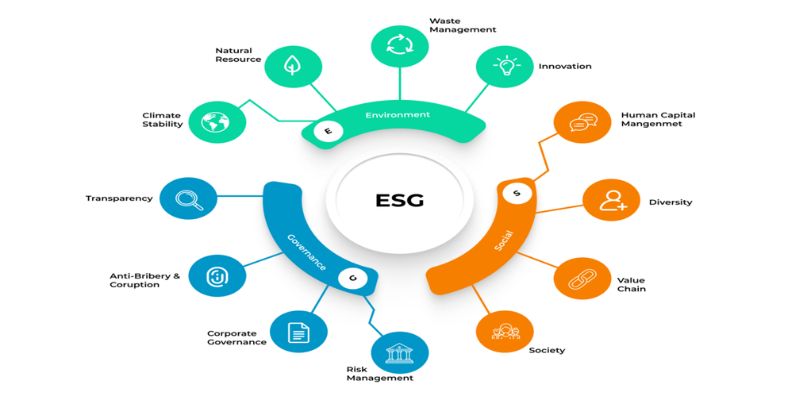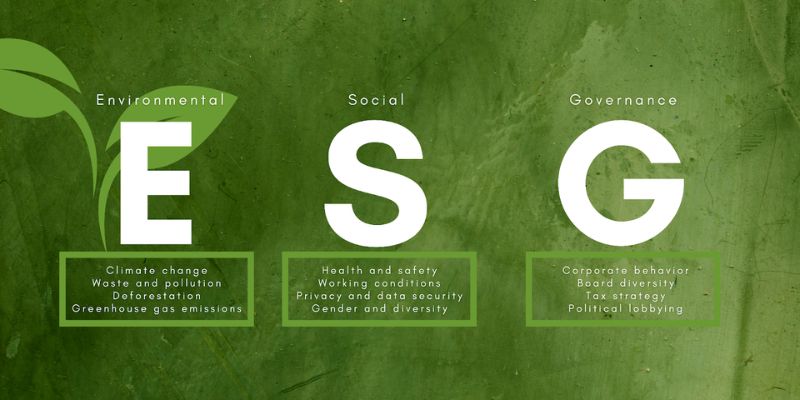Latest Developments in Sustainable Investing: Profits Meet Purpose
The world of finance is shifting. No longer is sterling performance the sole goal. Now, the Latest Developments in Sustainable Investing are here, blending profit with a passion for the planet. I’m seeing a clear trend: Investors are aligning their dollars with their values. This is not a fleeting fashion, it’s the future. I’ll guide you through the fresh waves in ESG that are reshaping the very fabric of investment strategies. Sit tight as we explore the rise of SRI, UN principles steering investments, green bonds fueling a cleaner future, and how corporations are bending towards sustainability under the weight of investor influence. Prepare to uncover innovations in sustainable portfolios that could redefine your approach to investing. This isn’t just about where the money is now; it’s about where the world is headed tomorrow.
ESG Trends Reshaping Investment Strategies in 2023
The Rise of Socially Responsible Investing (SRI)
We’re seeing more people put their money where their hearts are. They pick stocks and funds that match their values. It’s not just about making money. It’s about making a difference. This way of investing is called Socially Responsible Investing or SRI.
SRI means you choose companies that care about the planet and its people. Think about a company that makes solar panels instead of one that digs for oil. By choosing the solar panel maker, you’re helping our earth and still aiming for a good profit.
This year, updates in SRI are buzzing. People are using new ideas and tools to pick these kinds of investments. They look at things like how companies treat workers and what they do to protect the environment. This helps investors find places where their cash can help both their wallets and the world.
Integrating UN Principles for Responsible Investment
Now, moving beyond SRI, there’s another big topic: the UN Principles for Responsible Investment. You might wonder, “What are these principles?” They are six big ideas that guide investors to choose better ways to invest. They help answer questions like “Is this company looking out for the environment?”
These principles are like a promise to do more for our world through investing. They help find investments that are smart for your money and good for the future. As an expert, I can say that more and more people are following these principles in 2023.
Investors are taking climate risks seriously and checking if companies tell the truth about their impact on the climate. This kind of honesty helps everyone know which companies are truly green.
And what’s the result? We have more power as shareholders. We can push companies to be better. Companies are crafting new goals to stop adding to climate change, known as net-zero commitments.
Together, all these moves are reshaping how we invest. They show we can earn profits and still do right by the earth and its folks. This 2023 trend of tying profits with purpose is here to stay, and I’m all in for it.

Forging a Green Future: Financial Instruments and Opportunities
The Surge in Green Bonds and Clean Energy Funds
Green bonds are taking off. They fund eco-friendly projects. This year, their growth is robust. Investors buy these bonds to back clean energy and green buildings. They help cut emissions and fight climate change. As a smart investor, you aim for growth while doing good. In clean energy funds, we see solar and wind power lead the way. They get more cash as global demand soars. More money in these funds means more renewable energy for all.
Clean energy is only part of Sustainability-themed investments. They include projects that protect air, water, and land. People like you and me can invest in these themes. We help the planet and aim for solid returns too. Smart choices now build a better future.
Carbon-neutral portfolio strategies reduce climate risk. They balance carbon footprints by investing in green projects. This balances out the carbon they produce. It’s about profits meeting purpose. To follow these strategies, check the UN Principles for Responsible Investment. They guide you to invest with the environment in mind.
Exploring Biodiversity Financing and Sustainable Agriculture
Now let’s dive into biodiversity financing. This targets nature conservation. We’re talking forests, oceans, and wildlife. Investing here helps keep our planet rich with life. It’s critical for our survival and well-being. Projects get funding to safeguard habitats and species. Just as with forests, sustainable agriculture needs our attention.
In sustainable agriculture investing, you back farms of the future. We’re talking no pesticides and more organic methods. It’s better for the earth and for our health. Fresh funds flow into these areas. They help farmers grow food in ways that protect our planet.
Companies are ranked on how green they are. These corporate sustainability rankings guide investors. They show who is serious about going green. When a company promises to cut its carbon to zero, it’s a net-zero commitment. These pledges affect how we invest. We look for those who walk the green walk, not just talk the talk.
Every change in ESG rules shapes how we invest. We watch ESG reporting standards. They tell us how well companies do on the E, S, and G. It’s about being clear and honest in how businesses affect the world.
Community investing grows as we back local projects. This can be as direct as funding a new park or clinic in your area. These investments improve lives where we live.
To wrap things up, then, what you choose to invest in shapes the planet. From green bonds to renewable energy, your money speaks. It says you care about the earth and also about making money. Change starts with each of us. When we invest wisely, we help the world and secure our future.

Corporate Actions and Investor Engagement for Sustainability
The Role of Climate Risk Financial Disclosures
Companies now share how climate change affects their money. Money managers use this info to make smart choices. They look at climate risks before they invest. This means they can avoid money loss from climate problems. It also helps them find companies that fight climate change. This is good for the planet and for profits. The world has groups like the Task Force on Climate-related Financial Disclosures (TCFD). They help make rules on what companies should tell about climate risk. This shows if a company is thinking about its future in a warming world. As they share more, we can see who leads and who falls behind.
Advancing Net-zero Commitments and Ethical Investment Practices
Investors play a big part in making companies more green. They want them to bleed less carbon to stop more warming. Companies promise to cut their carbon to zero. They call this a net-zero commitment. To reach this, they change how they work. They use clean energy, waste less, and plant trees. Investors like these changes. They bring money to these green companies. This makes the companies grow and helps the Earth too.
Ethical investment now is more than just talk. It’s about doing the right thing with your money. Investors look for companies that are good for people and the Earth. They check that these companies do the right things. Not just in money, but in how they treat people and nature. This way, when you invest, you help build a better world.
As investors ask companies to do more good, some big changes happen. Here are a few:
- Green Bonds Growth: Now, there are more bonds just for green projects. The money from these helps to build things like wind farms and clean public transport.
- Impact Investing Insights: People are getting smarter about impact investing. They put money into companies that aim to fix social or environmental issues.
- Clean Energy Funds: People want to put more money into clean energy. This means investment in things like solar and wind power grows.
- Carbon-neutral Portfolio Strategies: More investors want “carbon neutral” in their portfolios. This means the money they invest does not add to Earth’s warming.
- Ethical Practices: They don’t just want profits. They want to know that their money backs up good behavior. This includes fair treatment of workers and caring for nature.
Investors and companies together can make a huge impact. They can guide us to a future that’s better for our planet. This is smart money moves meeting big heart choices. And it’s happening right now!

Innovations in Sustainable Investment Portfolios
Strategies for Carbon-neutral Portfolio Development
Investors now aim for carbon-neutral portfolios. This means picking investments that add zero net carbon to our air. To do this well, we need to follow key steps. First, figure out how much carbon the portfolio’s companies make. Next, invest in those that produce less. Lastly, balance the rest with carbon offsets or green investments. This way, the money works for both the planet and profit.
For example, solar and wind companies are good picks. They make clean power, which cuts carbon. Think of it as adding fresh air to your investment mix. It’s not just about avoiding harm. It’s also about funding the clean energy of tomorrow. By doing this, investors help the fight against climate change. They also tap into the growth of cutting-edge green tech.
Some funds track carbon footprints. They back companies leading in sustainability. This makes investing for a green future easier. You can find these funds by looking at their environmental, social, and governance (ESG) scores. High ESG scores often mean low carbon output. This is good news for your carbon-neutral goals.
Evaluating the Growth of Sustainable ETFs and ESG Data Insights
Sustainable exchange-traded funds (ETFs) are on the rise. They let people invest in many green stocks at once. This spreads out risk while backing many green ideas. What’s more, they often focus on clean energy and low-carbon companies. This makes them key tools for ESG investing.
ESG data tells us how well companies do against ESG goals. Let’s look at such companies for potential profits. Good ESG data points to smart moves in markets. It means a company cares about its impact and plans for the long haul. Better data means better investing choices. It helps us see which companies are truly walking the talk on sustainability.
By focusing on these two areas – carbon-neutral strategies and sustainable ETFs – you are already a step ahead. These choices shape the future. They also gear your investments towards a better world. Look for updates and insights on ESG trends to stay informed. As we see more advances in ESG data, we’ll witness even smarter investing. This is where profits meet purpose head on.
Now, imagine a world where every investment made helps the earth. Every dollar you put into the market is a vote for a green, healthy planet. This is no dream – it’s becoming our reality as we build greener portfolios. And as an investor or someone just thinking about it, you’re part of this change. Your choices in the market can drive a powerful movement towards better business.
So, keep an eye out for those green bonds growth stats, clean energy funds, and carbon-cutting plans. Keep asking questions, too. The questions from investors and customers can lead companies to act right. They can change the way the world does business.
Together, let’s fuel the surge in renewable energy investment. Let’s celebrate each step towards sustainable agriculture investing. Let’s back businesses aiming for net-zero carbon and those improving lives around the globe. Each choice builds a stronger, cleaner world for everyone.
In this post, we dove deep into how ESG trends are changing the way we invest in 2023. We started by looking at the climb of Socially Responsible Investing (SRI) and how it’s now crucial for picking stocks. Next, we saw big jumps in green bonds and clean energy funds. They’re making it easier to put money into a green future.
We didn’t stop there. We also talked about how companies are stepping up for a sustainable future. They’re fighting climate risk and aiming for net-zero targets. Last, we explored fresh ways to build investment portfolios that don’t hurt our planet. This includes carbon-neutral options and sustainable ETFs.
Here’s my final thought: Investing today is not just about the money you make. It’s about the mark you leave on the world. By choosing investments that care for our planet and people, you’re shaping a better tomorrow. Let’s keep that in mind as we make smart choices for both our pockets and our planet.
Q&A :
What are the latest trends in sustainable investing?
Sustainable investing continues to evolve, with current trends emphasizing transparency, impact measurement, and incorporation of environmental, social, and governance (ESG) factors into traditional financial analysis. Investors are increasingly looking at not just financial returns but also at the societal and environmental impact of their investments. Green bonds and ESG-integrated portfolios are gaining traction as more investors seek out companies with strong sustainability commitments. Moreover, shareholder activism for more sustainable business practices is on the rise.
How is technology influencing sustainable investing?
Technology plays a crucial role in the latest developments of sustainable investing. Advanced data analytics, artificial intelligence (AI), and blockchain are driving more informed investment decisions, better risk assessments, and increased efficiency in reporting sustainability metrics. Tech-driven platforms enable easier access to sustainable investment options for individual investors, and sophisticated algorithms are helping asset managers identify companies that align with specific ESG criteria.
What regulatory changes are affecting sustainable investing?
Regulatory changes are shaping the landscape of sustainable investing as governments worldwide implement policies to encourage sustainable business practices. The European Union’s Sustainable Finance Disclosure Regulation (SFDR) and the Taxonomy Regulation are key examples, aiming to increase transparency on the sustainability of financial products. In the US, the Securities and Exchange Commission (SEC) is considering rules that would require companies to disclose climate risks and ESG metrics. These changes underscore an increasing demand for standardized sustainability reporting, which is likely to affect investment strategies globally.
How are investor preferences impacting sustainable investing?
Investor preferences are exerting significant influence on the growth of sustainable investing. The rise in socially conscious millennials entering the investment market is driving demand for ESG-focused investment opportunities. Investors are not only looking to align their portfolios with their values but also to contribute to sustainable development goals while potentially reducing risk and uncovering new growth opportunities. Asset managers and investment firms are responding by developing a wider range of sustainable investment products to meet this demand.
What role do ratings and rankings play in sustainable investing?
Ratings and rankings are pivotal in facilitating sustainable investing by providing benchmarks for evaluating company and fund ESG performance. They offer insights into how well companies manage ESG risks and opportunities compared to their peers. Third-party rating agencies like MSCI, S&P, and Morningstar offer various ESG ratings that help investors make informed decisions. However, a lack of standardization in these ratings can pose challenges, emphasizing the need for investors to consider multiple sources and their own research when assessing the sustainability of an investment.

